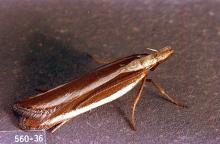Dichomeris marginella
Pest description and crop damage The adult juniper webworm is a copper-brown moth with white bands on the edges of the front wings. The moth is about 0.5 inch across. The larva is a yellowish to brownish caterpillar with dark brown lines on the back and a dark head. The webworm caterpillars initially feed by mining inside leaves, then gather to feed in small colonies or nests of webbed foliage as they mature. Due to their habit of feeding deep in the plant canopy, damage may be overlooked easily. Damaged foliage turns brown and is covered with dirty webbing. Considerable amounts of foliage may be spun together, and small trees may be completely webbed. Damage frequently is observed in early spring, March to May. This pest infests only Juniperus.
Biology and life history The caterpillars overwinter in the nest, which consists of webbed twigs, and resume feeding in spring. They pupate, and adult moths are flying in late spring. Eggs are laid on leaves of the current season's growth. Larvae feed first as leafminers, then feed on the surface of leaves, building silken tubes around the feeding site. They overwinter in small groups in these webbed sites. There is one generation per year.
Management-cultural control
Hand-pick caterpillars and prune out infested growth. Irish juniper (J. chinensis 'Stricta') is the preferred host, although Chinese juniper, red cedar, and Juniperus communis varieties aurea, horizontalis, depressa, hibernica, suecia, and squamata meyeri also are infested. Juniperus procumbens and J. squamata are infested only occasionally.
Management-chemical control
See:
Chemical Control of Nursery Pests
Sprays applied in late fall, winter, or early spring at relatively low temperature are effective against this pest.
For more information
Johnson, W.T. and H.H. Lyon (1991), Insects That Feed on Trees and Shrubs, 2nd ed., Cornell University Press (p. 30).




